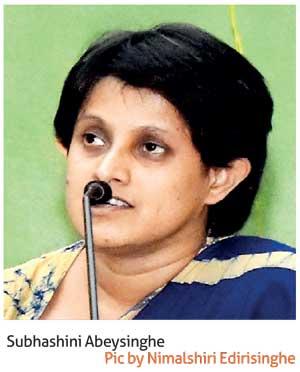12 Feb 2020 - {{hitsCtrl.values.hits}}
By Nishel Fernando
Sri Lanka’s export sector is out of sync with local and global developments despite the country’s graduation to the upper middle income bracket, and successive governments have engaged in re-canvassing the country’s export targets rather than addressing overdue fundamental problems in the sector, a leading trade economist opined.
“One of the problems with Sri Lanka’s export sector right now is that it is totally out of sync with local developments as well as with global developments. Sri Lanka has transited from being a low income country to an upper middle income country, but our exports are stuck in low-cost, low-skilled and labour intensive sector. There’s a total incompatibility in it,” Research Director at Verité Research, Subhashini Abeysinghe told a forum organised by the Ceylon Chamber of Commerce in Colombo last Monday.

According to Export Development Board (EDB) provisional data, Sri Lanka’s total merchandise and service exports reached US$ 16.14 billion in 2019 indicating a 1.44 percent year-on-year (YoY) growth backed by 5 percent YoY growth in services.
Sri Lanka was targeting US$ 20 billion in total exports in 2019, which was later revised down to US$ 18.5 billion.
“We are a country that sets targets, but always fail to meet these targets and then completely downgrade these targets,” Abeysinghe lamented.
Commenting on the US$ 18.5 billion total export target set for this year, she recalled that the country first set the US$20 billion merchandise export target in 2011.
“In 2011, for the first time, we surpassed US$ 10 billion threshold in exports. In that year, we set a target for 2020 to achieve US$ 20 billion in merchandise exports. When you have a merchandise export target of US$ 20 billion set in 2011 for 2020, after 10 years, we have a goods and service export target below US$ 20 billion. This is a significant downgrading of our export performance or we are becoming extremely pessimistic about our prospects and that’s extremely unfortunate,” she pointed out.
As Sri Lanka hasn’t deployed a robust mechanism to calculate service exports, she pointed out that these figures could be subjected to manipulation.
“Service export data is very difficult to calculate. When you say IT-enabled service exports, it’s not like they are coming from border agencies such as Customs to get recorded. You will have to deploy several measures including surveys to be able to measure it.
“This is a challenge in Sri Lanka; in my opinion; the country has not really developed a robust mechanism of collecting service export data. When you don’t have it, it makes it even easier for any government to manipulate the numbers,” she elaborated.
Speaking of the US$ 6, 500 per capita income target set by the for 2025, Abeysinghe stressed that without any significant change to Sri Lanka’s current export basket reflecting local and global developments, the country will not be able to achieve a double-digit export growth to support the per capita income target to become a high-income country.
“I can’t think of a country trying to achieve double digit export growth with an apparel sector accounting for 45 percent of merchandise exports and agriculture sector accounting for another 22 percent.
“This is not possible, because you are not compatible with your structure and every other country that was transitioning from low income to middle income transited out of low-cost, low-skilled and labour intensive sector,” she stressed.
Although, global value chains (GVC), which account for half of global trade today, are driven by electronics, electrics and automobile value chains, Abeysinghe noted that Sri Lanka is yet to become part of GVCs.
Further, she was also critical of Sri Lanka’s approach to China being limited to financing needs, instead of exports.
“China as a market for exports grew 4 times in terms of share, from 3 percent in 2000 to 11 percent of global trade by 2018. Unfortunately, Sri Lanka’s story about China is debt and loans. We are not exporting to China; only 2 percent of our exports go to China compared to our East Asian neighbours who export over 10 percent to China and most of their exports have doubled during the period,” she went on to say.
Commenting on free trade agreements (FTAs), which has become one of the most discussed and controversial topics in Sri Lanka in recent years, she pointed out that Sri Lankan exporters are at a disadvantageous position as rival exporters from other countries who get preferential access to competing markets under FTAs signed by their respective governments.
“In 2000, the world had only 100 FTAs. However, the world had 300 FTAs by 2018. In 2000, Asian countries had only 37 FTAs, but 2018 Asian countries had 160 FTAs and 70 percent of new FTAs that were signed included both goods and services. Sri Lanka shied away from this development as well.
“If you are an exporter, you would realise multitude of FTAs mean that when you try to access a new market, you are discriminated in the border, because someone else gets preferential access and you have to pay the normal duties and you are subject to other general barriers,” she pointed out.
Abeysinghe asserted that Sri Lanka needs to rethink and do things differently to realise the export growth that the country envisages.
16 Nov 2024 2 hours ago
16 Nov 2024 2 hours ago
16 Nov 2024 3 hours ago
16 Nov 2024 3 hours ago
16 Nov 2024 4 hours ago